by Jim LaMalfa
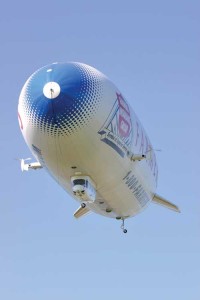
Farmers Insurance Airship, the largest airship in the world, is owned and operated by Airship Ventures of Moffett Field, Calif. The Zeppelin NT airship is 246 feet long -- 15 feet longer than a standard Boeing 747, and 50 feet longer than the largest blimp currently operating.
It is an understatement to say that this year’s EAA AirVenture Oshkosh, July 25–31, 2011 at Wittman Regional Airport, Oshkosh, Wis., had something for everyone. Hundreds of homebuilts, warbirds and vintage aircraft to see during the day, combined with the best musical entertainment at night, including REO Speedwagon, Aaron Tippin, and Gary Sinise & The Lt. Dan Band, gave EAA AirVenture 2011 all the right ingredients.
My sons and I started our walking tour of AirVenture 2011 on July 28th at the main gate. The Light Sport Aircraft (LSA) and other certificated aircraft made by Piper, Cessna, and long-standing venerables of general aviation, greeted us on the way to ConocoPhillips Plaza.
The first LSA we came to was the fiberglass C4 Early Bird Special made by Flight Design USA , N155RA. It is made of Kevlar and carbon fiber construction and features an all-glass instrument panel. The CTLS is a two-place LSA made in Germany and is powered by a 100 hp Rotax engine with a 2000-hour TBO. Also on display was a full sized model of the new four-place CTLS C4.
Pilatus, the Swiss aircraft company, displayed their sleek propjet. Piper had their “Mirage” on display with auxiliary fuel tanks and the latest Archer III. Walking toward ConocoPhillips Plaza we took note of the Aviat “Husky “A 1C, sometimes called a Super Cub on steroids. The Husky was wearing wide, thick skis surrounded by cotton “snow.” Cirrus aircraft featured their SR22 in Air Force blue, as well as an assortment of other models.
Two helicopters were keeping each other company, one an experimental version; the other, the Enstrom 480B. Enstrom helicopters are made in Menominee, Michigan and the factory rep told me they have 200 workers building aircraft as fast as they can and they need to add 50 more people to meet demand, which is nice to hear nowadays. The aircraft in demand is the military version, which is being ordered in goodly numbers by Japan and Thailand.
The “Champ” is alive and well in its current version made by the American Champion Aircraft Company. They also build the Citabria and Decathlon aerobatic aircraft, and Scout utility aircraft.
One may perhaps recall the rather flimsy-looking gyrocopters that would buzz about the ultralight airfield at the extreme south end of Wittman Field. No more! The homebuilder can buy Sportcopter II for around $65K in three kits and still comply with FAA rules that require the builder to construct 51 percent. This machine is nothing if not muscular, powered by the Lycoming IO 360 200 hp engine. The Sportcopter II also features sturdy main struts and a castoring nose wheel. The Sportcopter II cruises around 100 kts. The landing footprint for this autogyro is 20 feet, near helicopter performance.
Another homebuilt with utility performance on display was the Sportsman, sporting huge muskeg tires designed to land in marshy areas, the Alaskan pilot’s friend no doubt. The company claims you can build it in two weeks.
Lancair displayed their turbine propjet “Evolution” that can take off and land in 1,000 feet, and cruise at 300 kts at 28,000 feet. With this aircraft in your hangar, who needs the airlines?
Ettore Bugatti & His Race Plane
Many vistors to the EAA AirVenture Museum have been impressed with the sleek Bugatti 100 air racer that hung from the ceiling since 1996 in the Fergus Plaza directly opposite the main entrance. Bugatti came from an artistic Milanise family, but he turned his creative powers loose on racecars and engines. Bugatti’s racecars dominated racing before and after WWI, but he decided to take on the Germans in air racing as well. He designed a modernistic, for the 1930s, v-tailed racer, powered by two of his auto engines turning two contra-rotating propellers. The aircraft was designed for the Deutsche del Muerthe Cup Race, similar to the U.S. Thompson Trophy Air Race.
When the Germans invaded France in 1940, the racer was moved from Paris to a rural farm and stayed there, forgotten for 30 years. It eventually ended up being acquired by the EAA Museum and was restored sans engines. Now a group of Americans are bent on building a replica and flying it. I chatted with team leader Scotty Wilson at AirVenture 2011.
“There’s a lot of myth surrounding the aircraft,” Scotty commented. “I don’t think Bugatti hid it, but people in the late 1930s did recognize that it was a very advanced design. This is the first airplane that had a zero drag cooling system. The radiator is submerged inside the fuselage and predates the P51 by three years. Another feature that is unique are automatic flaps that sample air speed, manifold pressure and automatically sets the flaps. The airframe was designed by Louis D de Monge. The prototype never flew. A living witness states that once they got the engines installed, they never started the engine. The pilot who was going to fly the airplane was a WWI fighter ace named Maurice Arneau, also a race pilot. He was shot down and killed in the early days of WWII. Two contra-rotating propellers pulled the aircraft. There were two motor shafts, one inside the other, feeding power from two engines – one behind the other just behind the pilot. The airplane is structurally complete now. All of the parts are either in the hangar waiting installation or in the pipeline. If EAA gets the gearbox, which is being built in England, it should fly by the end of the year. Donations accepted: www.bugetti100p.com.
The v-tail on the 100 racer has two fins canted up and a third down and vertical, in what wind tunnel tests in the 1980s proved is the most efficient arrangement. The wings are swept forward. The aircraft was entirely built of wood and used two Bugatti 50B engines rated at 450 hp at 4500 rpm. The new replica actually uses main gears from the original aircraft.
Bob Hoover & Burt Rutan Tributes
Air show legend, Bob Hoover, was honored on July 26th during the air show with a special flight of his P-51 Mustang “Ole Yeller,” along side an Fw 190, the aircraft in which Hoover stole in a daring escape from a German prisoner of war camp during World War II. Additionally, well-known aircraft restorer, Bob Odegaard, flew a tribute to Hoover in a Shrike Commander. It was a good effort on Odegaard’s part, but not nearly the air show performance that Hoover once flew. Hoover had a packed crowd of admirers that evening at Theater In Woods to hear his tales of combat flying, air racing, test flying, and air show performing.
Thursday, July 28th was designated as a day to pay tribute to aviation legend and aircraft designer, Burt Rutan. Rutan has retired from Scaled Composites, Mojave, California, but not from designing new aircraft. Some of his aircraft were parked at ConocoPhillips Plaza, including his sailplane, the model 77 Solitaire, twin boom Boomerang, VariEze, Long Eze, Williams International twin corporate jet, Grizzly, and the Beech Starship, in which he contributed to the concept. Over 200 owners of Rutan-designed homebuilts flew to AirVenture 2011 and were prominently displayed in the homebuilt area south of air show central. Rutan’s current project is his “BiPod,” a roadable hybrid, gas-electric flying car. Scaled Composites is looking for a sponsor for the project.
“FiFi” – The Only Airworthy
Boeing B-29 Superfortress
Prominently displayed at ConocoPhillips Plaza, “FiFi” was welcomed back to Wittman Field after a four-year renovation. The Superfortress is owned by the Commemorative Air Force (CAF), based in Addison, Texas. FiFi last appeared at AirVenture in 1995.
Homebuilts & Warbirds of America
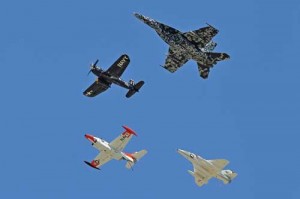
A “Legacy Flight’” featuring (L/R Top/Bottom): Vought F4U Corsair, McDonnell Douglas F-18 Hornet, North American T-2 Buckeye, and McDonnell Douglas A-4 Skyhawk. The aircraft fly-by was in recognition of the “Centennial of Naval Aviation,” the theme of EAA AirVenture Oshkosh 2011.
Some of the noteworthy homebuilt manufacturers we saw as we walked north toward the Warbirds of America area were Sonex Aircraft’s X1 (N111X1), a single-place easy starter for the first-time homebuilder; the Bearhawk Patrol, a two-place STOL 140 mph cruise Cub clone; and the StienAir Airboss, a composite twin boom LSA that weighs in at 850 lbs.
As we entered the warbirds paddock, there was an old friend, “Glacier Girl,” the only P-38 Lockheed Lightning that was salvaged from the Lost Squadron that abandoned a flight of P-38s and B17s in Greenland in 1943. Nearby, EAA was honoring the U.S. Navy’s Centennial with a number of venerable WWII Navy aircraft and a speaker in interview circle. On display were two F4U Corsairs; the North American B-25, “Devil Dog;” and a Grumman “Avenger” dive bomber with President George H. Bush’s name on the fuselage.
Parked in the grass tie-down area were more warbirds, such as a late model Supermarine “Spitfire” with the Rolls-Royce Griffon engine swinging a five-bladed prop, a Grumman F4 “Wildcat,” and a newly manufactured Focke-Wulf 190. At 98 percent the size of the original Luftwaffe fighter, Germany’s kitmaker Flug Werk says its creation is better than the original. Powered by an Asch 82 14-cylinder, double row radial engine that generates 1900 hp, the kit includes tail-wheel assembles from the original birds. Lighter than the original, the kit costs $760,000 plus the cost to finish the project. But if you just have to have an almost real Focke-Wulf 190, well you know where to get one. Rudy Frasca owns the Focke-Wulf 190 that was onsite at EAA AirVenture 2011, and he owns two more kits, along with a stable of 38 aircraft including a P-40 Warhawk, two Spitfires, and an FM2-Wildcat. Nice!
Electric Flight
GE-sponsored the second annual electric aircraft symposium, Friday, July 29th and Saturday, July 30th during AirVenture. The two symposiums featured notable aviation experts in electric flight such as Dr. Dale Carlson, GE Aviation’s executive for Advanced Engine Systems, and Sergei Sikorsky, son of Sikorsky Aircraft founder, Igor Sikorsky. One new addition to the electric-powered aircraft in the GE expo building was the “Electra One,” made by PC-Aero, a German company. The aircraft flew on Saturday, July 30th. The Lindbergh prize for Electric Aircraft Vision was given to PC-Aero on July 29th.
In Conclusion…
The world’s largest airship was at AirVenture 2011; also the first public showing of Boeing’s new 787 “Dreamliner;” a replica of the Curtis-Eley pusher, built by Bob Colbaugh, the original being the first aircraft to make a carrier landing on the deck of the U.S. Navy’s U.S.S. Pennsylvania in San Francisco Bay on January 18, 1911.
EAA AirVenture 2011, like previous versions, is the world’s premier aviation event with something for anyone interested in aviation. Good show, EAA!








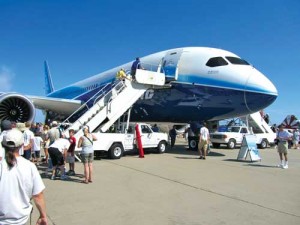
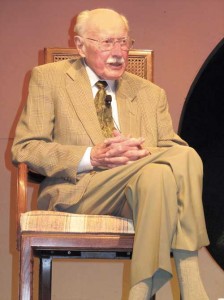
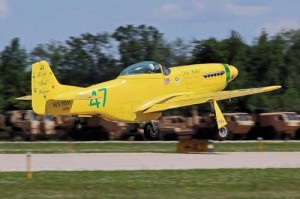
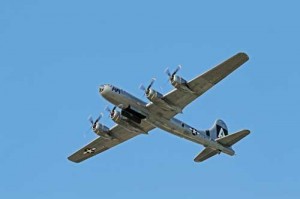
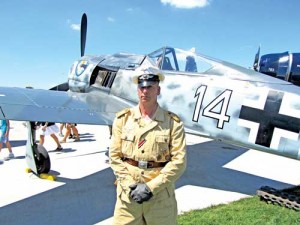



Pingback: โปรแกรมพรีเมียร์ลีก
Pingback: ดูซีรี่ย์ออนไลน์
Pingback: emisii de praf